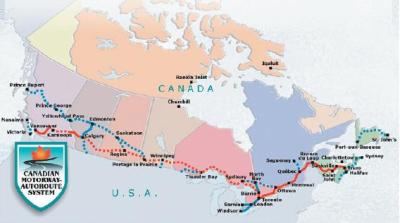
As the worldwide “Great Recession,” (as characterized by the International Monetary Fund), has developed, there have been many proposals to expand transportation infrastructure. One is to build high-speed passenger rail lines in Canada. Another alternative is to establish a world-class highway system of freeways, also known as motorways, autobahns or autoroutes in other parts of the world.
Motorways and autoroutes are fully grade separated roadways that permit traffic to flow generally uninterrupted between urban areas. They do not have at-grade cross traffic. The United States, Europe and Japan have motorway systems that reach virtually all of their major urban areas. China is developing a system that will eventually equal the length of the world’s most extensive system, which is in the United States. Mexico and Brazil have developed substantial systems. Canada, however, does not have a comprehensive system and is the largest developed nation in the world without a comprehensive intercity motorway system. In addition, some nations have built highways to premotorway standards, which provide superior capacity, speed and safety compared to conventional roadways.
Motorways have a significant positive impact on national and local economies, principally because saving time improves productivity. Moreover, motorways are far safer than conventional roads, because there are no grade crossings.
Canada is largely unconnected by motorways or autoroutes. On average, the metropolitan areas are connected to less than one-quarter of the other metropolitan areas. Two of the nation’s six metropolitan areas with more than 1,000,000 people Calgary and Edmonton) are not connected to any other metropolitan area by motorway, and Vancouver is connected only to Abbotsford. Calgary and Edmonton are also the only major metropolitan areas not connected to the motorway systems of the United States and Mexico. As a result, much of Canada, one of the three North American Free Trade Agreement (NAFTA) partners, is not connected to the motorway systems of the United States and Mexico.
For many trips between metropolitan areas within Canada, it takes less time to travel through the United States on its motorways. The principal problem is the long, crowded, slow, two-lane stretch of roadway between the Manitoba-Ontario border, between Sudbury and Parry Sound, and much of the route between the Alberta border and Kamloops, B.C. Canada pays an economic price for this lack of a world-class highway system, both in terms of manufacturing and tourism.
It is proposed that a national motorway and pre-motorway be established, the Canadian Autobahn. This system would include the following improvements:
- All non-motorway segments of the transcontinental route from Halifax through Toronto to Vancouver would be upgraded to motorway standard. These improvements should be completed within 10 years and would cost approximately $28 billion (2009$).
- The inclusion of all existing intercity motorways and autoroutes
- Other principal routes would be upgraded to at least pre-motorway standard. The longest of these is the Yellowhead route; Edmonton and Calgary to the Canada U.S. border; Ottawa to Sudbury; and across the island of Newfoundland. These improvements should be completed within 15 years and would cost approximately $33.5 billion).
Moreover, new roads to the North need to be considered. Less than 300 kilometers remain to complete a link to the port city of Churchill, Manitoba. Given the concerns about national sovereignty in the North, the potential for a road to Nunavut (Rankin Inlet or eventually Iqaluit) deserves a serious review.
Because of the importance of tying the nation together, it would be appropriate to spend federal and provincial funding on the Canadian Autobahn. User fees, such as a dedicated gasoline tax (as in the United States) or tolls (as in France, China and Mexico) could finance it.
View entire study in PDF (25 pages)



